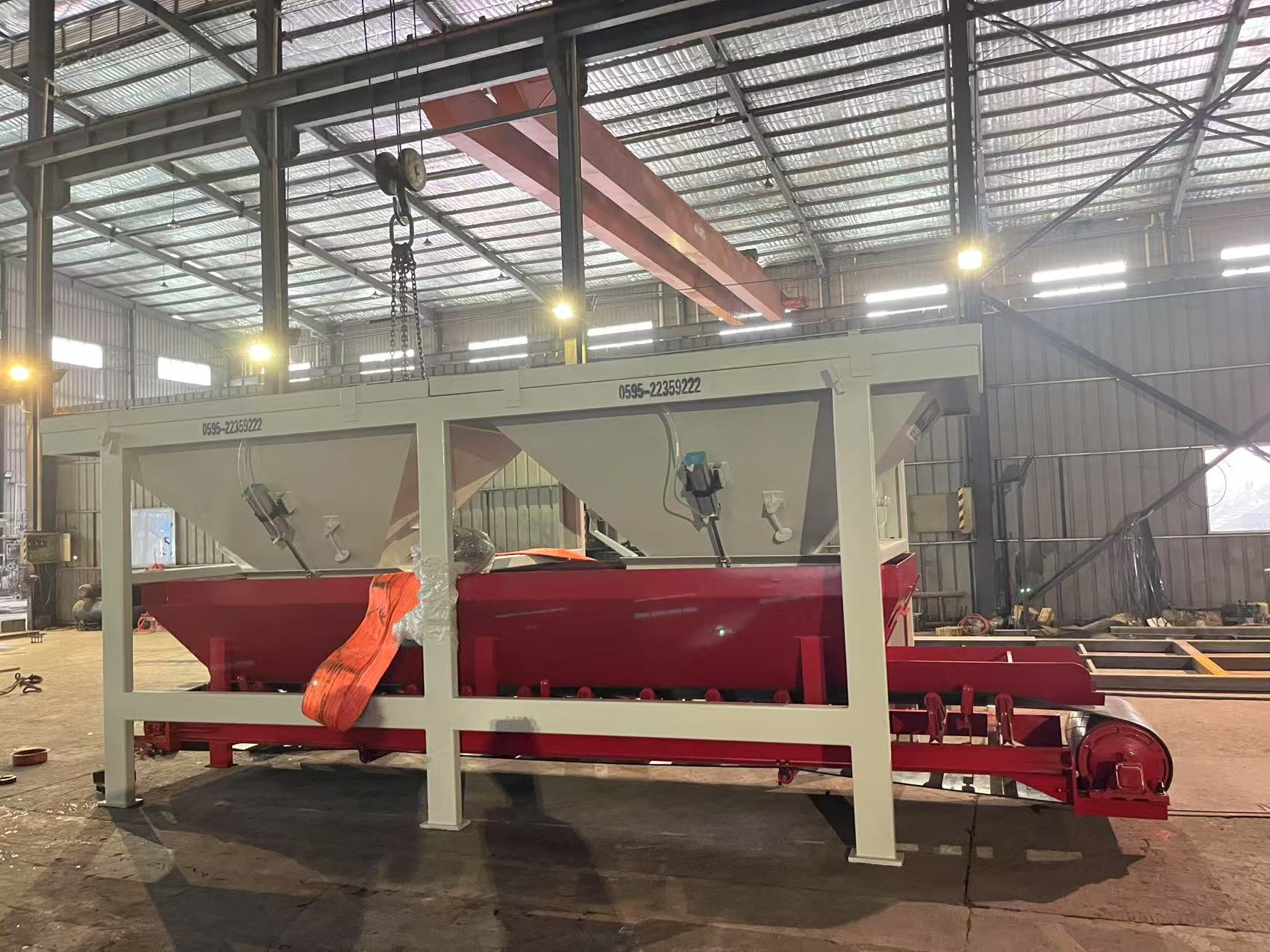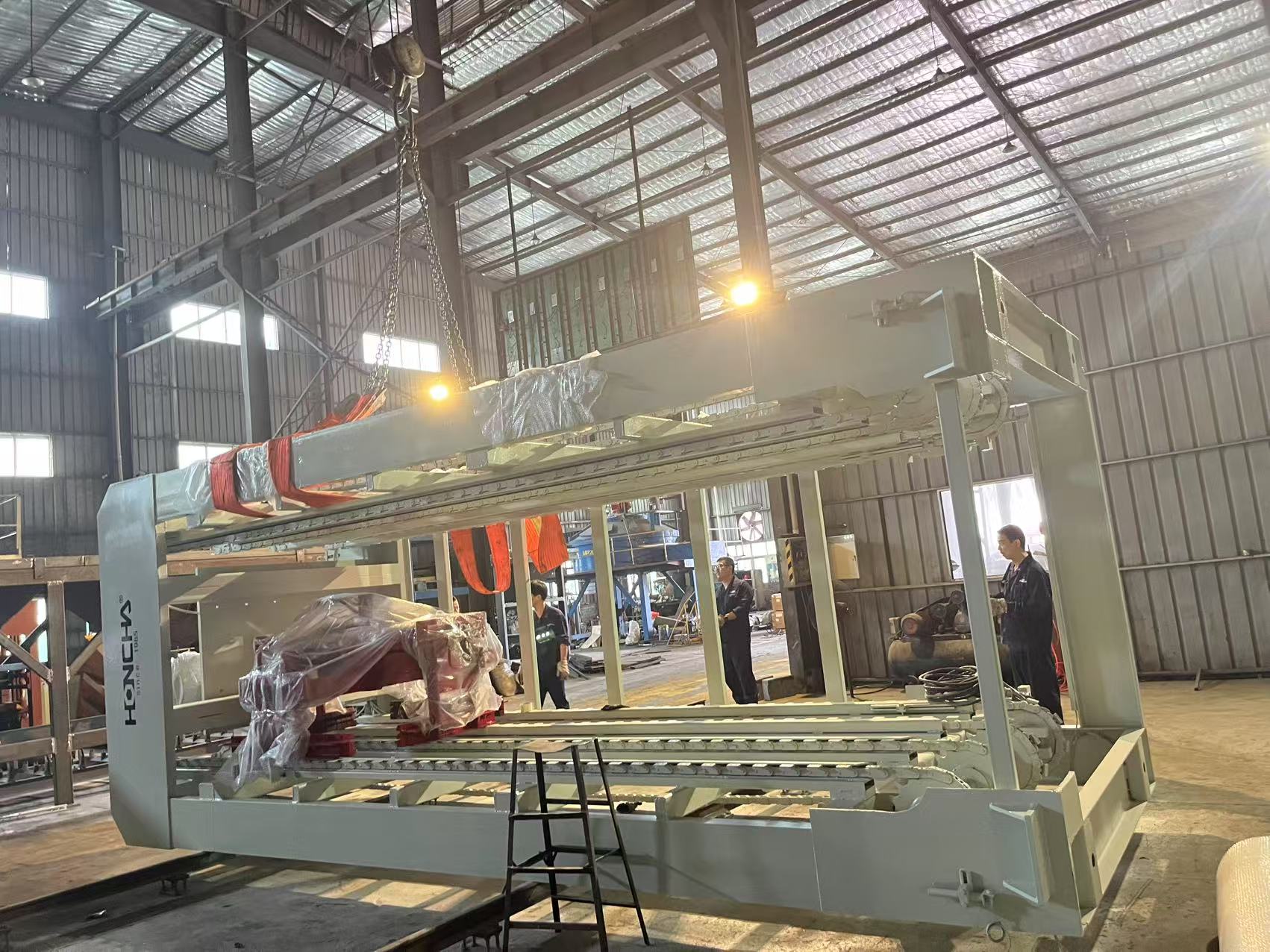1.Batching Machine: The “Steward” for Precise and Efficient Concrete Batching
In scenarios involving concrete production, such as construction projects and road construction, the batching machine is one of the key pieces of equipment for ensuring concrete quality and production efficiency. It is like a precise and efficient “batching steward”, controlling the first crucial procedure in concrete production.
I. Basic Structure and Principle
The batching machine is mainly composed of storage bins, a weighing system, a conveying device, and a control system. Multiple storage bins are generally set up, which can respectively store different aggregates such as sand and gravel to meet the demand for various raw materials in concrete production. The weighing system is the core part. With the help of technologies such as sensors, it can accurately measure the feeding amount of each type of aggregate to ensure the accuracy of the mix proportion. The conveying device is responsible for transporting the weighed aggregates to the mixer. Common ones include belt conveyors, etc., which have stable conveyance and are not prone to material residue. The control system is the “brain”. Operators set the batching parameters through it, and the equipment automatically completes the batching process according to the instructions to realize automated operation.
II. Precise Batching for Quality Assurance
The properties of concrete, such as strength and durability, largely depend on whether the mix proportion of raw materials is precise. The weighing system of the batching machine has high precision and can strictly control the dosage of aggregates such as sand and gravel in accordance with construction requirements, with extremely small errors. For example, when producing high-strength concrete, the requirements for the aggregate proportion are strict. The batching machine can accurately feed materials, ensuring the stable performance of each batch of concrete and avoiding fluctuations in concrete quality caused by errors in manual batching, thus guaranteeing project quality from the source. For projects with high requirements for concrete quality, such as high-rise buildings and bridges, the precise batching of the batching machine is particularly crucial.
III. Efficient Production for Improved Efficiency
In large-scale concrete production scenarios, the batching machine can achieve continuous and rapid batching. Multiple storage bins prepare materials simultaneously, and the weighing and conveying processes are smoothly connected, which can cooperate with the mixer for efficient operation and significantly shorten the production cycle. Compared with traditional manual batching, it is not only several times faster but can also operate continuously for 24 hours (under the premise of proper maintenance), meeting the demand for concrete supply during the rush period of large projects, improving the overall construction efficiency, and accelerating the project progress.
IV. Adapting to Diverse Needs with Flexible Configuration
The batching machine can be flexibly configured according to different project needs. The number and capacity of storage bins can be adjusted as required, and it can be adapted to the production of various types such as ordinary concrete and special concrete. Whether it is a small precast component factory producing small batches of diverse concretes or a large-scale mixing plant producing a single type of concrete on a large scale, it can meet the production requirements by adjusting the parameters and combinations of the batching machine, and has strong universality and adaptability.
V. Reducing Costs, Being Energy-Saving and Environmentally Friendly
Precise batching reduces the waste of raw materials such as aggregates. Accurate feeding according to demand avoids overfeeding or underfeeding, saving raw material costs. At the same time, automated operation reduces labor input and lowers labor costs. Some advanced batching machines focus on energy conservation and environmental protection in design. For example, optimizing the conveying device to reduce energy consumption; sealing the storage bins to reduce dust emission and improve the production environment, which conforms to the concept of green construction and helps the project meet environmental protection standards.
However, the batching machine also needs proper maintenance during use. Regularly calibrate the weighing system, check the wear condition of the conveying device, etc., to ensure long-term stable and precise operation. As the construction industry continuously raises requirements for concrete quality and production efficiency, the batching machine is also continuously upgraded, developing towards a more intelligent, more precise, and more environmentally friendly direction. In the future, it will play a more important role in engineering construction, providing strong support for creating high-quality and high-benefit construction projects, becoming an indispensable “capable assistant” in the concrete production process, and promoting the development and progress of the entire construction industry.
2.Unveiling the Palletizer: The Intelligent “Handling Hero” of Modern Factories
In the production workshop of a factory, there is such a “handling hero” that silently contributes – the palletizer. It may seem like a huge steel structure, but it has a delicate “mind” and flexible “skills”, becoming an indispensable part of automated production, efficiently and accurately handling the task of stacking materials.
I. Appearance and Basic Structure
In terms of appearance, this palletizer has a regular frame structure, like a “steel castle” tailor – made for material handling. It is mainly composed of a main frame, a grabbing device, a conveying track, a control system and other parts. The main frame is the “skeleton”, supporting the weight of the entire equipment and the force during operation, being stable and reliable; the grabbing device is like a flexible “palm”, which can accurately pick up and put down materials, and different designs can be adapted to various materials such as boxed, bagged, and桶装 (barreled); the conveying track is the “track”, allowing the executive components of the palletizer to move according to the planned path; the control system is the “nerve center”, directing the coordinated operation of various components.
II. Working Process and Principle
The job of the palletizer is to neatly stack the materials on the production line into piles for convenient storage and transportation. When the materials reach the designated position through the conveyor line, the control system will issue instructions, and the grabbing device will act quickly. According to the preset palletizing mode (such as in rows, staggered, etc.), it will accurately grab the materials, then move along the conveying track to the pallet area and place them steadily. This series of actions relies on sensors to perceive positions, motors to drive movements, and program logic control, like a precisely cooperating “small team”, quickly and without mistakes, turning messy individual materials into neat piles.
III. Efficient Operation to Increase Production Capacity
In large – scale production scenarios, the palletizer is the one responsible for efficiency. Manual palletizing is not only slow but also prone to fatigue and errors, while the palletizer can work continuously for 24 hours (with proper maintenance). It can complete the grabbing – stacking action multiple times per minute. The materials on a production line can be quickly palletized by it, greatly shortening the production cycle and making the factory’s production capacity “soar”. For example, the beverage crates in a food factory and the raw material bags in a chemical factory, the amount that used to take several people a whole day to handle can now be done by the palletizer in a few hours, and it can maintain a stable rhythm without delaying the subsequent warehousing and logistics links.
IV. Precise Palletizing to Ensure Quality
The “precision” of the palletizer is well – known. It relies on sensors and program control, and the position error is extremely small when grabbing and placing materials. The stacked piles are neat, beautiful and stable. For some materials that are afraid of collision and have high requirements for stacking precision, such as the packaging boxes of electronic components, manual palletizing may easily cause collisions if not careful, but the palletizer can operate steadily, avoiding material damage, ensuring product quality from the palletizing link, and reducing losses caused by improper palletizing.
V. Flexible Adaptation for Diverse Production
The materials in different factories vary greatly, but the palletizer can deal with them flexibly. By adjusting the grabbing device and setting different palletizing programs, it can be adapted to various material forms such as boxes, bags, and barrels. It can also change the number of stacking layers and arrangement methods according to the warehouse space and transportation requirements. Whether it is a small – sized enterprise producing diverse small – batch products or a large – scale factory producing a single type of material on a large scale, the palletizer can “adapt to local conditions” and adjust its “working mode”, becoming a “versatile hand” on the production line.
VI. Cost Reduction, Efficiency Increase, and Assisting Smart Factories
Using a palletizer, a factory can reduce labor input and lower labor costs, and also reduce material losses caused by human errors. In the long run, although there is a cost for purchasing the equipment, the efficiency it improves and the quality it ensures can save the factory a lot of money. Moreover, the palletizer is an important part of the construction of smart factories. It cooperates with other automated equipment (such as conveyor lines, robots, etc.), making the production process smarter and smoother, and promoting the factory to upgrade towards digitalization and intelligence.
Of course, the palletizer also needs good maintenance. Regularly check the track lubrication, the wear of the grabbing device, and the operation of the control system, so that it can work efficiently and stably all the time. With the development of intelligent manufacturing, the palletizer will become more intelligent. For example, integrating AI visual recognition to independently adjust the palletizing strategy; deeply linking with the MES system to make production scheduling smarter. In the future, it will shine in more factories, being a powerful and smart “handling hero”, pushing the entire manufacturing industry towards a more efficient and intelligent direction, and making the “handling story” in the production workshop more and more wonderful!
Post time: Jun-21-2025

 +86-13599204288
+86-13599204288

